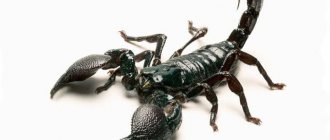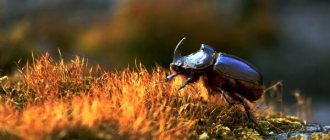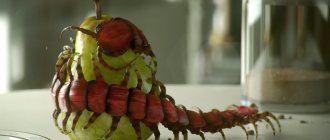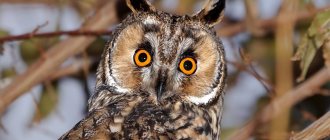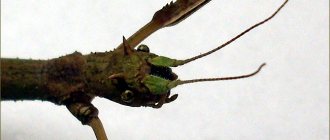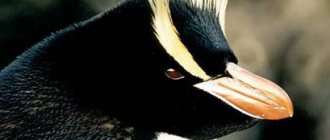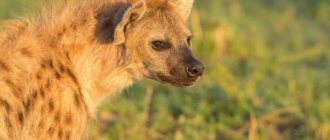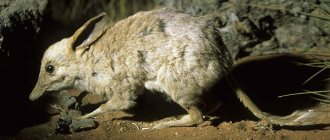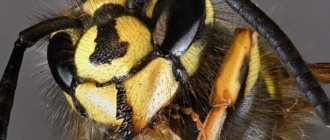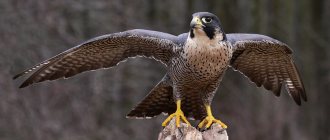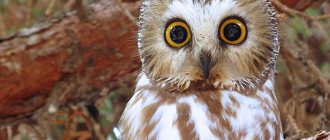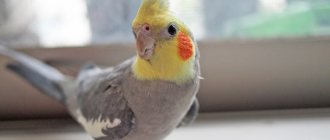Stick insects are the largest group of the order Privideidae (there are approximately 2,500 species). At first, entomologists drew attention to the unusual rod-shaped shape of insects, and then found out that stick insects have many other advantages. It is not only their appearance that is extremely interesting, but also their biology and behavior.
Classification
- Type: Arthropods
- Subtype: Tracheal-breathing
- Class: Insects
- Order: Phasmatodea
- Families: Heteronemiidae; Phasmatidae; Bacillidae.
What stick insects look like
Like any insect, stick insects have a body of three parts (head, thorax and abdomen), three pairs of jointed legs, compound eyes and a pair of antennae. Some species have wings and fly, while others are limited in movement.
Insects range in size from 1.5 to 60 centimeters in length; males are usually much smaller than females. Some species have cylindrical, stick-shaped bodies, while others come in flat, leaf-like forms.
Reproduction and lifespan
Insects go through several molts throughout their lives. After the last of them, the female becomes able to bear fruit. Offspring appear as a result of asexual reproduction, which is fraught with the appearance of a large number of females.
In order for their species not to disappear, there must be at least some possibility of fertilization with the help of males. This happens sometimes. After which the male, having fertilized the partner, transfers the spermatophore to her.
From this method of reproduction, young individuals of different sexes are born, the main goal of which at first is gluttony. They strive to get to food as quickly as possible. The lifespan of these amazing insects is no more than a year.
Adaptation of stick insects to the environment
Stick insects mimic the color of their environment; they are green or brown, although black, gray or even blue stick insects are found.
Some species, such as Carausius morosus, even change pigmentation to suit their environment, like a chameleon.
Many species make swaying movements, the bodies of insects swaying from side to side, like leaves or branches in the wind.
When camouflage is not enough, insects use active forms of defense to fight off predators. For example, the species Eurycantha calcarata produces a terrible-smelling substance. In other species, brightly colored wings become invisible when folded. When stick insects feel threatened, they spread their wings, then fall to the ground and hide their wings again.
Stick insects are nocturnal creatures that spend most of the day motionless, hidden under plants. This tactic helps them avoid predators.
Nutrition
All types of stick insects prefer to eat plant foods. Their favorite treat is leaves of trees and shrubs. Each species has its own preferences in this food.
They choose a safe night time to get food. But even at night they cannot be completely safe. Therefore, caution is paramount for them at this time.
They prefer to search for provisions for themselves alone. But among them there are species that do this in large flocks and can disfigure an entire tree in one night.
For domestic stick insects, the presence of greenery all year round is important. Therefore, breeders have to take care of this. They store food frozen and feed it to their pets every day. If your supplies are running low, you can try feeding the stick insects a leaf of hibiscus or tradescantia, they will not refuse such food.
10) Eastern snake-necked turtle
These turtles have a long neck, which protrudes far from the shell in order to look around. They live in Australia, mainly in fresh water swamps, ponds and lakes. In fact, they do not exactly imitate plants, but allow algae to grow on their shells, so the shell resembles a rock with vegetation. This appearance allows the turtle to camouflage well.
Do you know that the animal world has its own almost mystical creatures? Today on our site the stick insect is a ghost insect. Moreover, he received this status in a completely scientific way.
The earth's fauna is amazing and diverse. But has anyone ever heard that there are ghosts in our nature? No? But scientists know these creatures very well; it was the fauna researchers who came up with the name for one of the orders of the insect class. This squad is called the ghost ones. And the representative of these strange creatures is an arthropod insect called a stick insect.
Ghost leaf moth
Analogues in folklore
Similar monsters are found in many legends. If you speak English, a fairly comprehensive collection of information can be found in the Slender Wikia.
Russian
The pole is extremely long and thin, sometimes wanders around the streets at night, looks into windows, warms his hands in the chimney and scares people. This is some kind of pathetic crank, who is condemned to wander around the world forever without any purpose or position.
V. I. Dal, “On beliefs, superstitions and prejudices of the Russian people”, 1880
German
The Germans believed in a certain Der Großmann.
“He will ask you a question. If you answer correctly, he will break your arms and legs. If you answer incorrectly, his fingers will enter you through your neck and tear out your heart.” — L. Mugler
INTERESTING FACTS, INFORMATION
- The stick insect, native to Southeast Asia, is the largest insect in the world. Its length is 33 cm, and with its forelimbs stretched forward, this monster can reach a length of more than half a meter.
- Huge differences in the numbers of males and females of the same species are rare. However, males of some species of stick insects have not yet been found in nature. In species reared in laboratories, there are an average of 4,000 females per male.
- If a stick insect loses a leg, it grows a new one. With age, the insect loses the ability to regenerate limbs.
- Some species of stick insects throw out the contents of their stomachs onto the enemy.
Our smaller brothers
Rats
Perhaps a rat is not the first thing that comes to your mind when your child suddenly expresses a desire to receive a pet as a gift. In vain. The rat is a highly sociable and intelligent animal.
which requires minimal care.
In addition, they are very playful and love to tinker with all sorts of toys, balls, strings, and can even play with a roll of toilet paper to their delight. So rats are the perfect little pets?
It turns out that it is so. In addition to being friendly, intelligent and sociable, they show great affection for their owners
. In other words, be prepared for the fact that your children will also be inflamed with reciprocal love.
Rats have amazing memories for such small creatures. They are very unpretentious in food, although you can also purchase the most suitable food for them in the appropriate stores. However, like hamsters, rats have a very short life cycle of two to three years.
Gerbils
Gerbils are collective animals that form colonies in their natural environment. That is why it is recommended to keep them in small groups - from two to four individuals. But don't be alarmed - they are very inexpensive to maintain.
.
They prefer a mixed diet, very often storing quite large reserves of food (if the opportunity arises)
You can pick them up and stroke them, but you should do this very carefully, since gerbils are extremely gentle creatures and can easily be harmed. There are a very large number of species of gerbils, but the so-called Mongolian gerbil is often kept at home
These animals are very clean animals and practically do not smell. Unlike hamsters, gerbils are not nocturnal animals.
Mongolian gerbil is often kept at home.
. These animals are very clean animals and practically do not smell. Unlike hamsters, gerbils are not nocturnal animals.
They are quite independent creatures, so they can easily entertain themselves for long periods of time. The life expectancy of gerbils is quite short - from three to four years, for which it is worth preparing mentally in advance.
Ferrets
Ferrets are extremely active, terribly inquisitive and extremely agile animals. At the same time, they are very cute to look at and have a fluffy coat that is very pleasant to the touch. They live longer than many of their smaller cousins
- from eight to ten years.
As soon as you let your ferret out of the cage, he will immediately start running around the house, exploring every nook and cranny, so you shouldn’t leave them outside the cage unattended. If the ferret is outside, someone must look after him, otherwise you will be tired of looking for him later.
They definitely need more attention than rats or hamsters, as they don't feel very comfortable if they are in a cage all day. It turns out to be a rather paradoxical situation - ferrets should not be left unattended outside the cage, but it is also undesirable to keep them in the cage all day long.
, even if you are not at home.
Ferrets are willing to be handled. They will not bite you, unless, of course, you accidentally harm them. These animals can play with you or your children all day long. They acquire their cute special attractiveness somewhere closer to three years.
Chinchillas
Of all the furry pets offered on this list, chinchillas are the fluffiest. Their fur is thick and silky. Thanks to this, chinchillas are probably the most pleasant to be held and stroked
.
On the other hand, chinchillas don't really like being cuddled. It's better to give her the opportunity to run around your home. An adult chinchilla reaches a length of up to 30 centimeters or even more, and females are larger than males.
Chinchillas practically do not emit an unpleasant odor. And even their secretions do not smell for several days. These cutest animals live from 10 to 15 years.
The color of the fur of these creatures varies from the lightest tones to soot black.
Chinchillas do not require much attention. They eat special food, which can be freely purchased at pet stores. It is better to keep male chinchillas in pairs. But the females of these animals are solitary, so they can be kept alone.
Feeding
For most domestic insects, you need to buy dead larvae, flies, and even mice... But not for the herbivorous stick insect. They will have enough leaves and branches of fruit and berry trees such as currants, apple trees, rose hips and others. It is not recommended to feed insects with oak leaves, which often harbor fungi that are fatal to stick insects.
- Food can be placed throughout the insectarium, so it will be green, beautiful and free for your pets. The main thing is to monitor and replenish food supplies on time.
- You need to prepare supplies for the winter. Dry some, freeze some, and, if possible, grow some at home in pots.
- Naturally, for the normal functioning of pets, the insectarium must have several types of edible plants.
- There is no need to provide stick insects with a water bowl for their own safety - instead, spray the walls and branches with a spray bottle. Try not to get on the insects themselves, so as not to cause them severe stress.
6) Malaria mosquito (sandfly)
Parasitic malaria mosquitoes pose a significant danger to people. In their genus they have about 10 subspecies of their family. Basically, Indian and African species are more dangerous. These small dipterous insects are carriers of parasites and infections. The malaria mosquito goes through a whole cycle of infection. Initially, he becomes infected with Plasmodium from a human host. The malarial plasmodium then multiplies inside the mosquito. Then the mosquito, after 5-10 days, becomes the carrier of the infection and its main source. There are mosquitoes that carry not only human, but also animal plasmodium. The most dangerous diseases transmitted by malaria mosquitoes are: malaria, threadworms, yellow fever and encephalitis.
